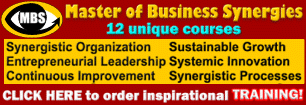|
Corporate Culture Achieving Higher Results Through Sustaining Employees' Focus on What To Do and How To Do It |
|
by Vadim Kotelnikov, Founder, The first-ever Ten3 Business e-Coach for Innovative Leaders, 1000ventures.com
"Everybody talks about the weather, but no one does anything about it" - Mark Twain
|
What is Corporate Culture? Culture refers to an organization's values, beliefs, and behaviors. In general, it is concerned with beliefs and values on the basis of which people interpret experiences and behave, individually and in groups. Cultural statements become operationalized when executives articulate and publish the values of their firm which provide patterns for how employees should behave. Firms with strong cultures achieve higher results because employees sustain focus both on what to do and how to do it. Case in Point: 25 Lessons from Jack Welch At General Electric (GE), corporate values are so important to the company, that Jack Welch, the former legendary CEO of the company, had them inscribed and distributed to all GE employees, at every level of the company. The sum is greater than its parts at GE as both business and people diversity is utilized in a most effective way. A major American enterprise with a diverse group of huge businesses, GE is steeped in a learning culture and it is this fact that makes GE a unique company. As Jack Welch puts it: "What sets GE apart is a culture that uses diversity as a limitless source of learning opportunities, a storehouse of ideas whose breadth and richness is unmatched in world business. At the heart of this culture is an understanding that an organization's ability to learn, and translate that learning into action rapidly, is the ultimate competitive business advantage."...More Case in Point: Dell Computer Corporation "I wish it were possible for me to interact with everyone at Dell as I used to. But it's not possible to scale the number of interactions to be consistent with the growth of the company", says Michael Dell6, Chairman and CEO of the Dell Computer Corporation. "We've found there are, however things you can do to bridge the distance between you and your people in a larger organization, and develop the fast-paced, flexible culture that's a source of competitive advantage...More
|
|||||||||||||||||||||||||||||||||
Bibliography:
-
"Corporate Culture and Performance", John Kotter and James Heskett, 1992
-
"Results-Based Leadership", Dave Ulrich, Jack Zenger and Norm Smallwood, 1999
-
"Hard-Core Management", Jo Owen, 2003
-
"Driving Growth Through Innovation", Robert B. Tucker, 2002
-
"Developing a Culture for Diversity", Chris Speechly and Ruth Wheatley, 2001
-
"Direct from Dell", Michael Dell with Catherine Fredman, 1999


